STEM (Science, Technology, Engineering, and Math) toys are much more than just entertainment—they’re a powerful way to combine play with learning. By engaging the mind and hands, these toys encourage curiosity, creativity, and the development of critical thinking skills. STEM toys are designed to make learning fun and interactive, which can help users, whether children or adults, better understand complex concepts in science, technology, engineering, and mathematics without feeling overwhelmed.
For children, STEM toys serve as an excellent foundation for learning essential life skills. They encourage exploration, experimentation, and logical thinking while providing an opportunity to learn through trial and error. This hands-on approach makes abstract concepts, like coding or physics, more relatable and easier to grasp. For adults, these toys are equally beneficial, offering a way to develop problem-solving skills, relieve stress, and even serve as a productive hobby that sharpens the mind.
What sets STEM toys apart is their ability to bridge the gap between fun and education. They aren’t limited to classrooms or textbooks but instead bring real-world learning into everyday play. Whether it’s building a robot, solving a puzzle, or designing a structure, STEM toys create an environment where users of all ages can learn at their own pace while enjoying the process. By choosing the right STEM toy, you can unlock a world of possibilities that stimulate intellectual growth and provide hours of engaging, purposeful fun.
STEM toys are specially designed tools that incorporate principles of Science, Technology, Engineering, and Mathematics into play. Unlike traditional toys, which might focus on entertainment or imagination, STEM toys aim to teach foundational concepts in a fun, hands-on way. They’re interactive, thought-provoking, and often involve solving problems or completing tasks, which can help users develop essential skills for both academics and everyday life.
For a toy to qualify as a STEM toy, it typically includes one or more of the following characteristics:
STEM toys are for everyone! They’re not limited to specific age groups or educational levels.
The primary purpose of STEM toys is to teach complex ideas in a way that feels accessible and enjoyable. Instead of sitting in front of a textbook or computer screen, users actively engage with concepts, often without even realizing they’re learning.
Unlike traditional toys, which often focus solely on entertainment or pretend play, STEM toys are purpose-driven. For example:
STEM toys strike a balance between play and education, offering a way to turn fun into meaningful learning for all ages. Whether you’re looking to spark an interest in technology, enhance problem-solving skills, or simply enjoy an enriching activity, STEM toys provide endless opportunities to grow and explore.
STEM toys are not just for play—they’re tools that foster learning, creativity, and essential life skills. Whether you’re a parent looking to enhance your child’s education or an adult searching for a stimulating hobby, STEM toys offer countless benefits. Here’s why they’re worth considering:
STEM toys shift the focus from passive learning (like watching videos or reading instructions) to active, hands-on engagement.
When you physically build a circuit or program a robot, the learning experience becomes immersive and memorable.
STEM toys often require users to experiment, troubleshoot, and iterate to achieve a goal. This process:
These problem-solving skills are valuable not just in academics but also in everyday life and professional settings.
One of the biggest barriers to education is boredom. STEM toys tackle this by making learning exciting and engaging.
With STEM toys, the line between learning and playing blurs. Children might not realize they’re learning physics while building a marble run or studying geometry while constructing with magnetic tiles.
In today’s technology-driven world, STEM skills are in high demand. STEM toys lay the groundwork for future success by introducing concepts like coding, robotics, and engineering early.
STEM toys are designed for a wide range of ages and skill levels.
This inclusivity makes STEM toys a great choice for families, classrooms, and even casual hobbyists.
STEM toys inspire curiosity and a love for discovery that doesn’t stop when the toy is put away. They encourage a mindset where users continually seek answers, ask questions, and solve problems—a valuable trait for both kids and adults.
Choosing STEM toys is more than a purchase—it’s an investment in learning, creativity, and growth. They offer the perfect balance of fun and functionality, making them a thoughtful choice for anyone who values education and entertainment combined.
STEM toys come in a wide range of categories, each focusing on specific aspects of Science, Technology, Engineering, and Mathematics. Choosing the right category depends on the learner’s interests, age, and skill level. Here’s a detailed look at the main types of STEM toys and what they offer:
Science toys are ideal for hands-on exploration of biology, chemistry, and physics. These toys make complex scientific concepts tangible and engaging.
Examples:
What They Teach:
Technology toys focus on digital skills, coding, and understanding how devices work. They help users transition from consumers of technology to creators.
Examples:
What They Teach:
Engineering toys encourage creativity, spatial reasoning, and an understanding of how things are built. These toys are perfect for budding architects, mechanics, or designers.
Examples:
What They Teach:
Math toys transform numbers and calculations into interactive and fun activities. They’re perfect for making abstract math concepts more relatable.
Examples:
What They Teach:
Some STEM toys combine aspects of multiple categories, offering a holistic learning experience. These toys are particularly effective for encouraging creativity and collaboration.
Examples:
What They Teach:
STEM toys provide an opportunity to explore science, technology, engineering, and math in ways that feel natural and fun. By choosing toys from these categories, you can inspire curiosity and build skills that last a lifetime.
Selecting the perfect STEM toy can be a challenge, given the wide variety available. To help, here’s a detailed look at eight exceptional STEM toys, each offering unique opportunities for learning and creativity. These toys cater to various interests and skill levels, ensuring there’s something for everyone.
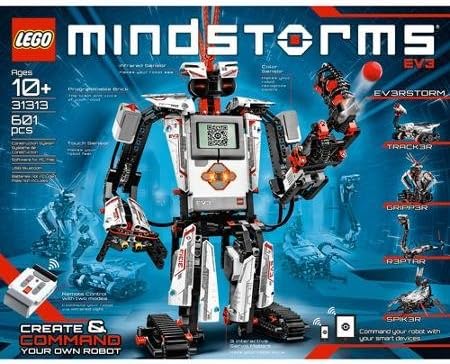
The LEGO Mindstorms Robot Inventor Kit is a hands-on tool that brings engineering and programming to life. With over 900 LEGO Technic pieces, sensors, motors, and a smart hub, it allows users to build and program robots capable of walking, talking, and even guarding rooms. This kit is designed to inspire creativity, problem-solving, and technical skills in a fun, engaging way.
The kit includes five detailed robot designs:
The robots can be programmed using Scratch-based drag-and-drop coding, perfect for beginners, or Python, catering to advanced learners. The smart hub with Bluetooth connectivity, LED lights, and sensors makes the robots highly interactive and responsive to commands.
This kit not only teaches coding but also emphasizes engineering principles, creativity, and logical thinking. It’s expandable with other LEGO Technic sets, making it versatile and long-lasting. Whether for kids 10+, teens, or adults, this kit offers endless learning opportunities while being a lot of fun to use.
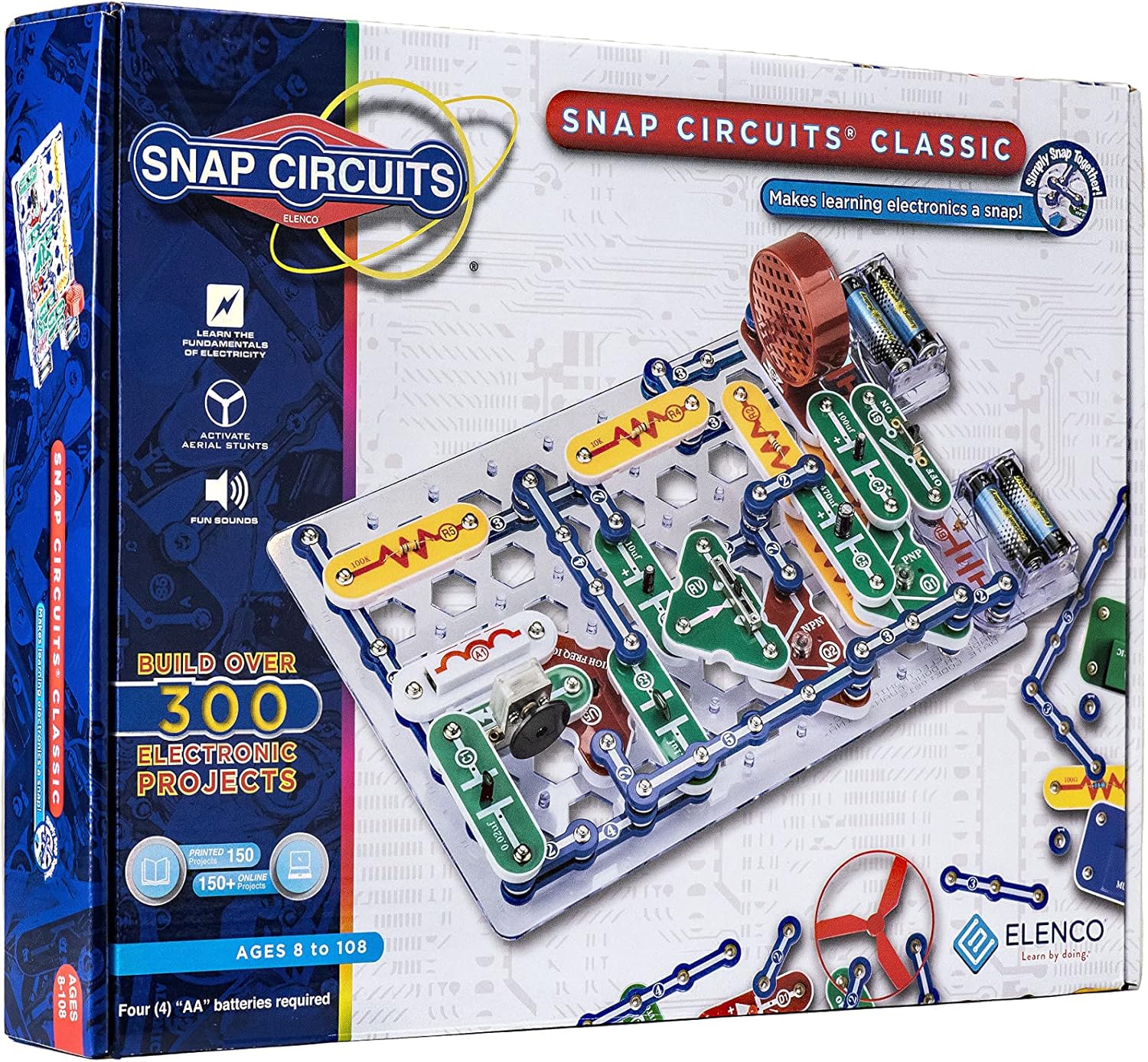
The Snap Circuits Pro SC-500 is an engaging way to explore electronics and circuitry through hands-on projects. Designed with simplicity in mind, it uses snap-together components that eliminate the need for soldering, making it safe and accessible for users as young as eight years old.
This kit includes over 75 color-coded components, such as resistors, switches, and capacitors, which can be combined to create more than 500 projects. Examples include working AM radios, doorbells, light-controlled alarms, and even simple lie detectors. The pieces snap together like puzzle pieces, simplifying complex electrical concepts into something intuitive and fun.
The included instruction manual provides clear, step-by-step guidance, with projects ranging from beginner to advanced. This gradual progression allows users to start with simple circuits and build up to more complex designs, developing their understanding of how electricity flows and how components interact.
Snap Circuits Pro SC-500 is an excellent tool for teaching electrical engineering principles, problem-solving, and logical thinking. It’s perfect for curious kids, teens, and even adults looking for an engaging introduction to electronics. Its sturdy, reusable components ensure it remains a valuable learning tool for years.
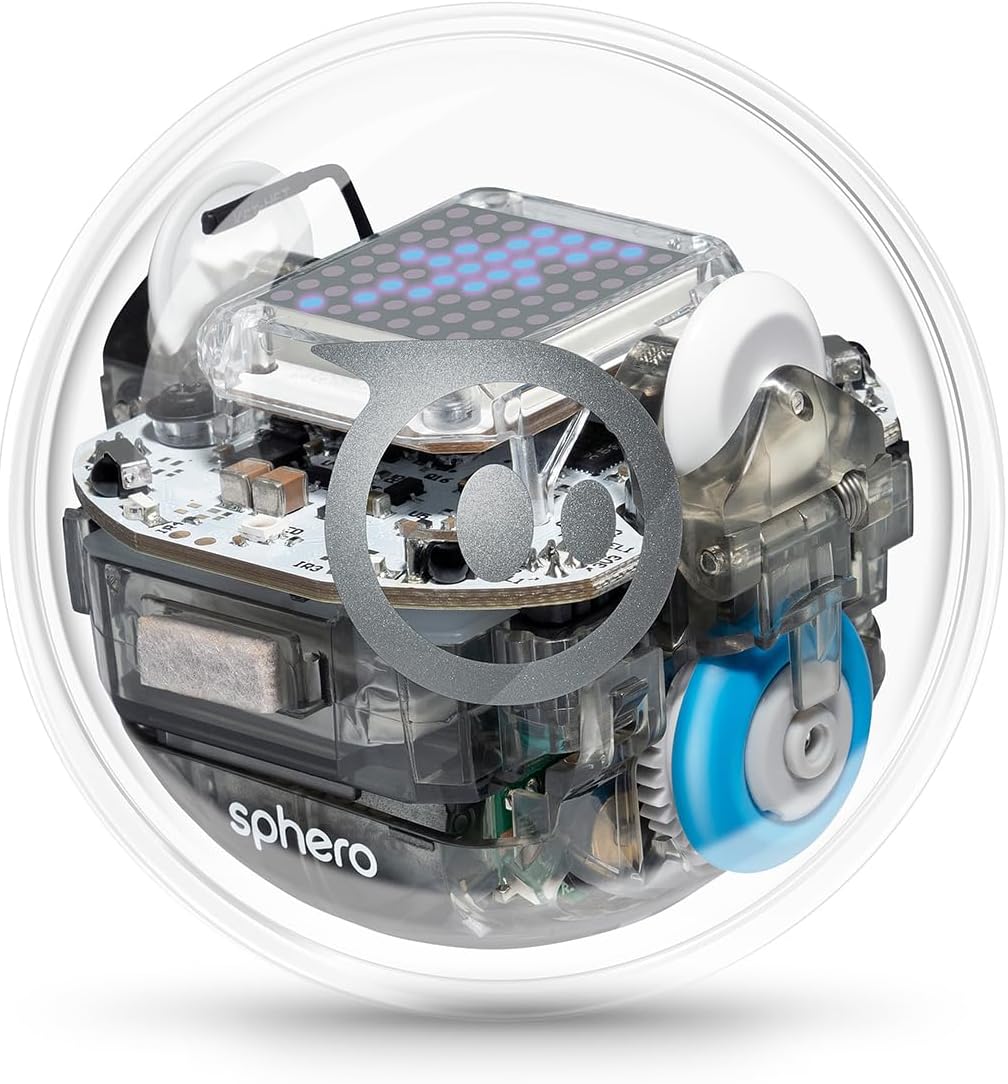
The Sphero Bolt is an innovative programmable robot designed to make coding fun, interactive, and accessible. Shaped like a durable, transparent ball, it’s packed with advanced features, including an LED matrix display, sensors, and Bluetooth connectivity, making it a versatile learning tool for kids and adults alike.
The LED matrix display is a standout feature, allowing users to program custom animations, text, and graphics that appear on the robot. It’s controlled through the Sphero Edu app, which supports multiple programming languages, including:
Sphero Bolt’s sensors, including a gyroscope, accelerometer, and compass, allow it to react to its surroundings, follow programmed routes, and perform unique maneuvers. Its infrared communication capability even lets multiple Bolts interact, opening up possibilities for group activities and collaborative projects.
This robot is highly durable and waterproof, making it suitable for indoor and outdoor use. It’s powered by a rechargeable battery, offering up to two hours of playtime on a single charge.
Sphero Bolt teaches essential coding and problem-solving skills while encouraging creativity and exploration. From coding challenges in the app to creating obstacle courses or games, it offers endless opportunities for learning. It’s ideal for users aged eight and up, providing a fun and practical introduction to programming and robotics.
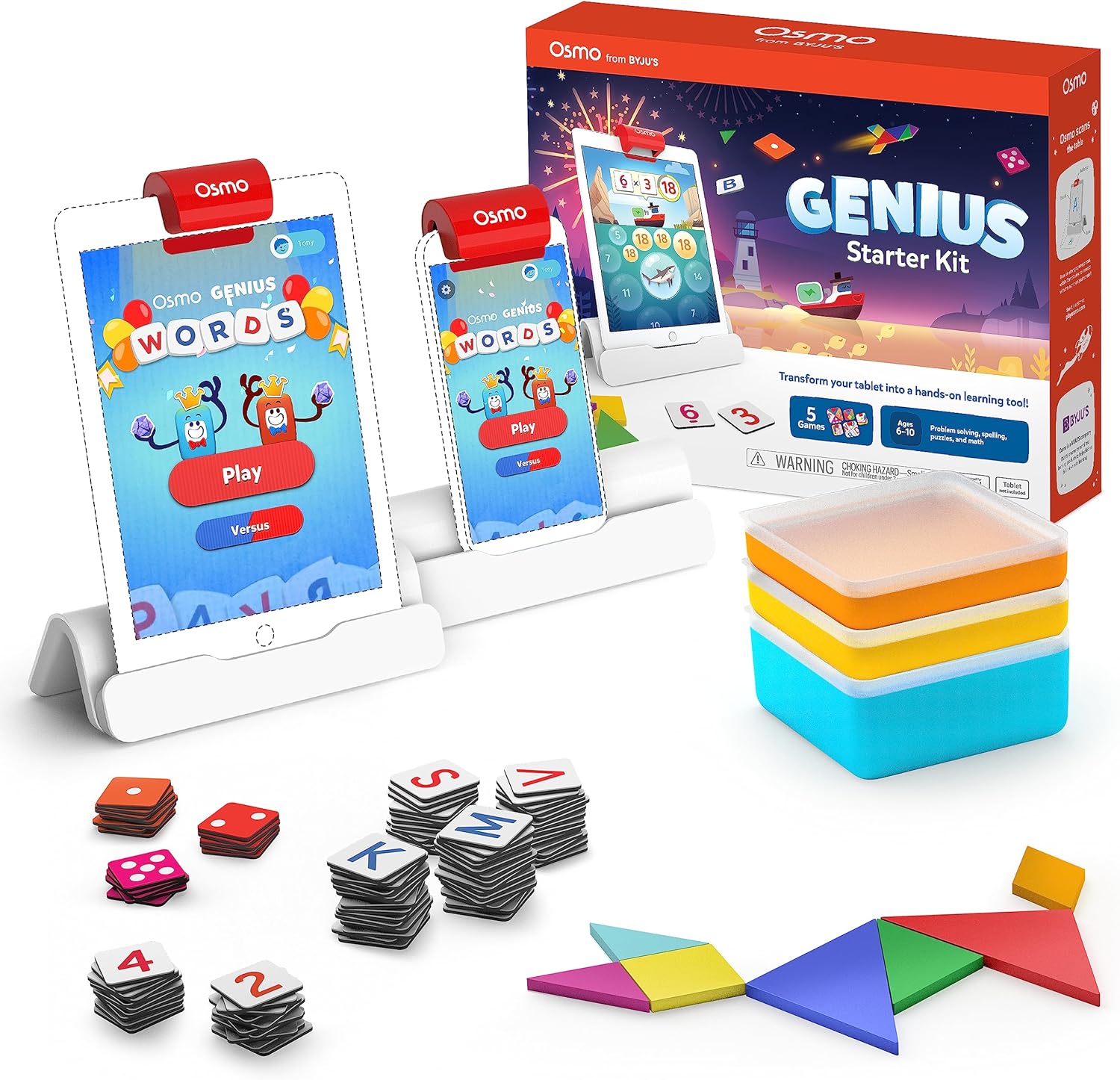
The Osmo Genius Starter Kit is a highly interactive and hands-on learning system designed to make education engaging and fun for kids. By combining physical play with digital interactivity, it transforms an iPad into a tool for exploring core STEM concepts like math, problem-solving, and spatial reasoning.
This kit includes:
Five Educational Games:
The kit’s appeal lies in its ability to bridge the gap between screen time and hands-on learning. Kids physically manipulate the included game pieces, and the iPad reflects their actions in real-time, creating an immersive and engaging experience.
Osmo adapts to the user’s skill level, making it suitable for children ages 5 to 10. The games grow in difficulty as the user progresses, ensuring they’re always challenged but not overwhelmed.
Osmo is perfect for parents or educators seeking a fun, educational tool that keeps kids engaged. It teaches fundamental STEM skills while fostering creativity, logical thinking, and problem-solving. Whether used at home or in classrooms, the Osmo Genius Starter Kit is an excellent way to make learning enjoyable and effective.
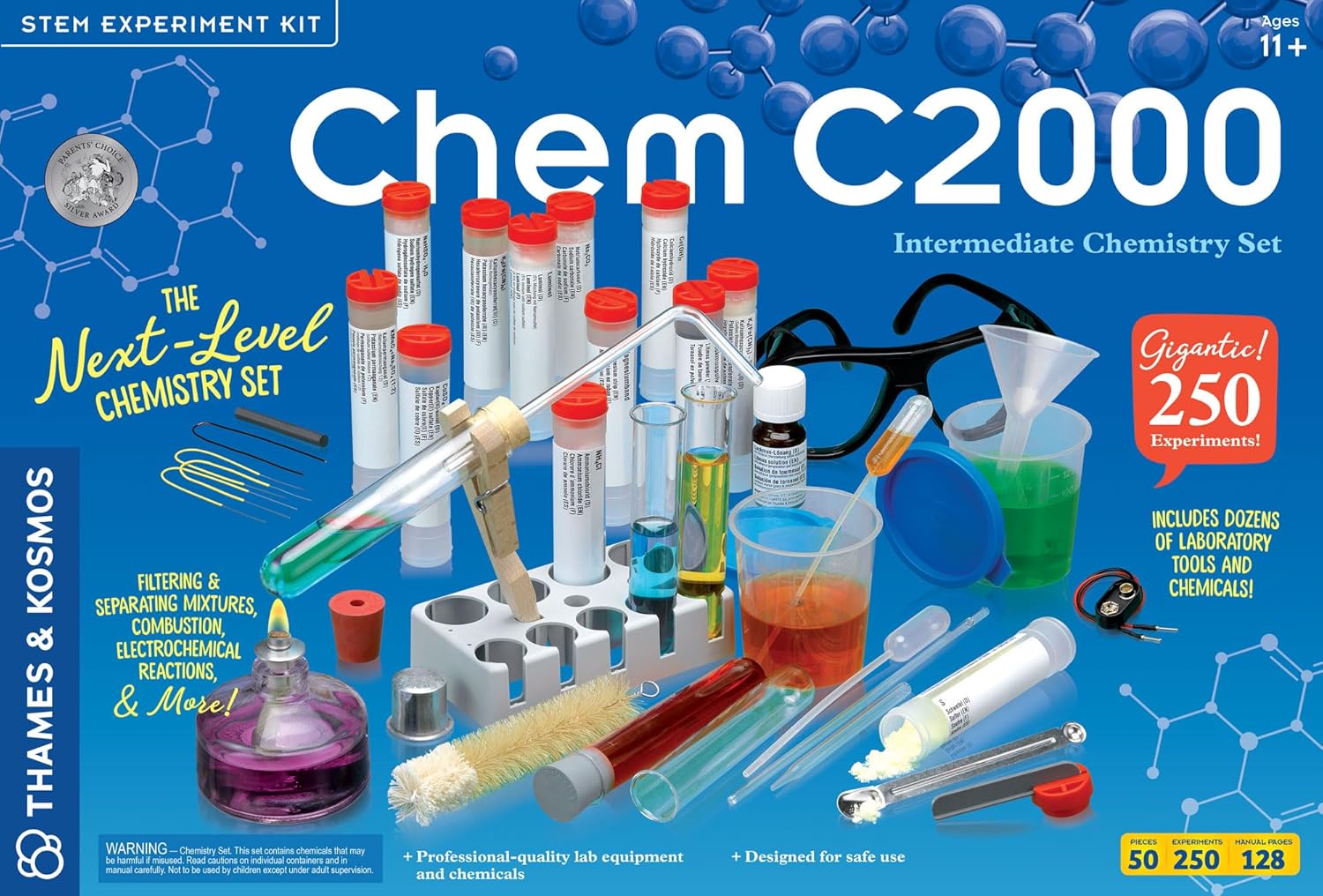
The Thames & Kosmos Chem C2000 Chemistry Kit is a comprehensive tool for exploring chemistry through hands-on experiments. It includes real lab equipment like beakers, test tubes, and pipettes, as well as a variety of safe chemicals for over 250 experiments. Users can learn about topics like acids and bases, gas production, crystal growth, and molecular structures.
The detailed 128-page manual guides users step-by-step, explaining not just how to perform the experiments but the science behind them. It’s designed to make complex concepts accessible, connecting chemistry to everyday life.
Ideal for ages 12 and up, this kit fosters critical thinking and teaches lab safety, making it perfect for curious teens or hobbyists. Whether for home or classroom use, it offers an engaging introduction to the fascinating world of chemistry.
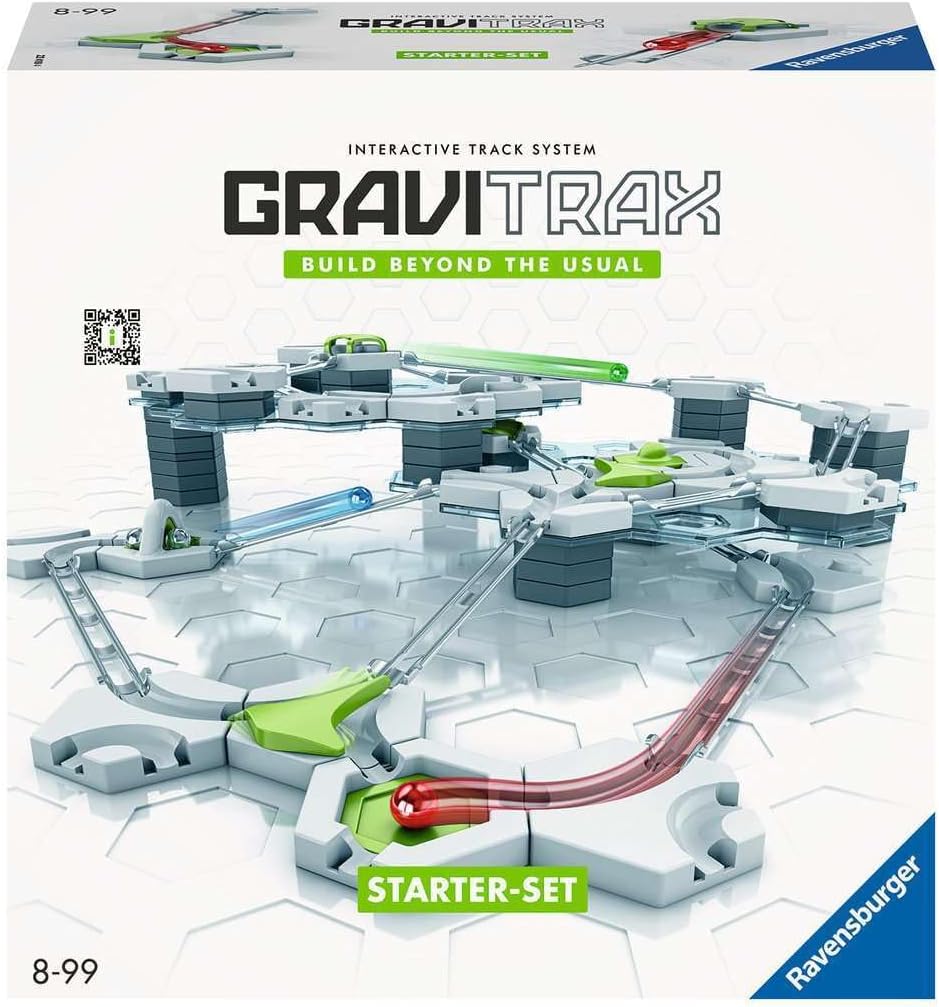
The Gravitrax Marble Run Starter Set is an interactive engineering and physics toy that lets users design and build their own marble track systems. With over 100 components, including tracks, tiles, and unique elements like magnetic cannons and vortexes, it encourages creativity and problem-solving.
Users can experiment with gravity, momentum, and kinetic energy as they construct tracks to guide the marbles to their destination. The modular system allows for endless designs, from simple runs to complex multi-level tracks, making it both challenging and fun.
The kit includes a detailed guidebook with instructions for starter builds and design challenges, but it also leaves plenty of room for open-ended play. Suitable for ages 8 and up, Gravitrax combines fun with a hands-on approach to learning physics and engineering principles. It’s expandable with additional sets, ensuring it grows with the user’s skills and imagination.
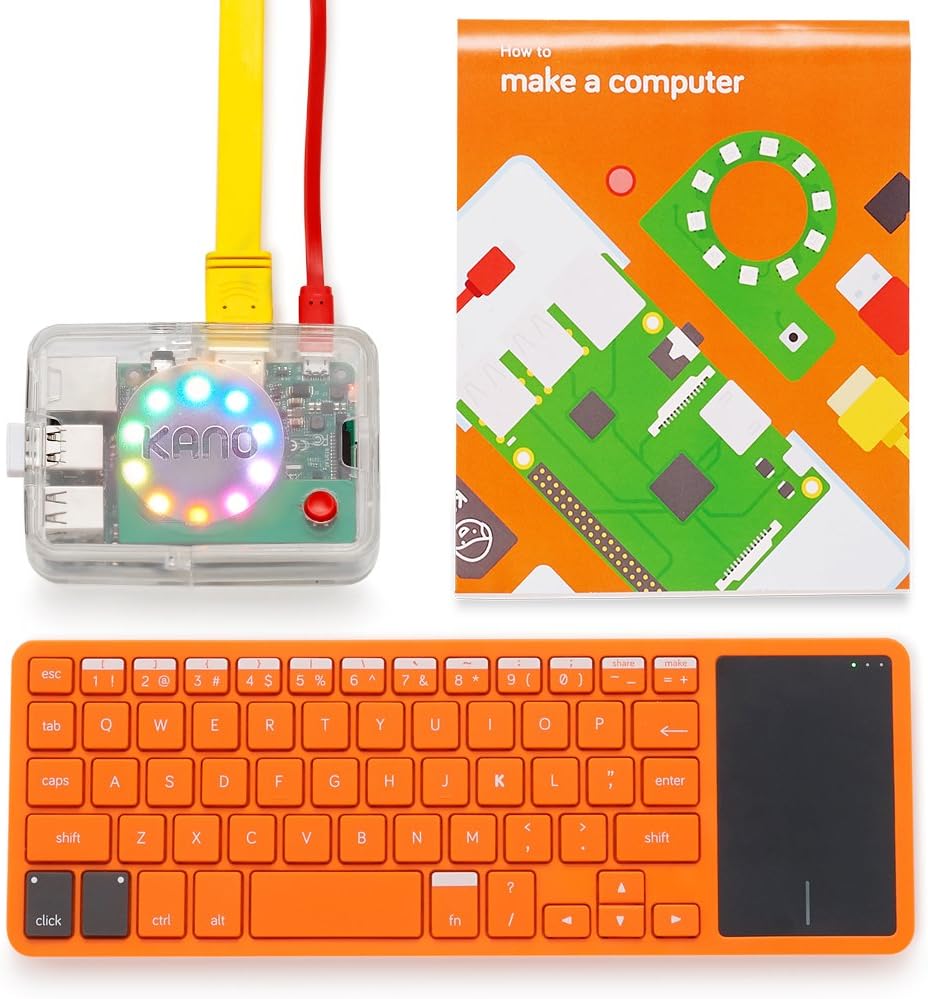
The Kano PC Computer Kit is an all-in-one educational tool that allows users to build their own fully functional computer. It’s designed to teach the basics of hardware assembly, coding, and digital literacy in a hands-on, engaging way. The kit is powered by a Raspberry Pi-based system and comes with everything needed to assemble the device, including a screen, keyboard, battery, and pre-installed educational software.
This kit stands out because it combines learning with functionality. After assembly, users can use the Kano PC as a regular computer for browsing, writing, or gaming, while exploring coding projects and interactive lessons. The accompanying Kano software introduces users to block-based coding, Python, and JavaScript through fun challenges like building apps, creating animations, or even hacking Minecraft.
It’s ideal for ages 10 and up, making it perfect for curious kids, teens, and adults. The Kano PC Computer Kit provides a practical introduction to the inner workings of computers while encouraging creativity and problem-solving. It’s a fantastic choice for anyone interested in technology or looking to develop 21st-century skills.
These STEM toys are not just fun—they’re valuable tools for learning and creativity. Whether for a young child, a teen, or an adult, there’s a STEM toy on this list that’s sure to inspire and engage.
Choosing the right STEM toy can be challenging with so many options available. To ensure your selection is engaging, educational, and age-appropriate, here are some key factors to consider:
STEM toys are designed for a wide range of age groups, and choosing one that matches the user’s developmental stage is essential.
Selecting an age-appropriate toy ensures it’s engaging without being too overwhelming or too simple.
Think about what skills or concepts you want the toy to teach. Different STEM toys focus on various aspects of learning:
Choose a toy that aligns with the user’s interests or fills gaps in their learning.
STEM toys should challenge users but remain enjoyable. Consider these points:
STEM toys are often used repeatedly or involve intricate construction. To ensure longevity:
Safety is especially critical for younger users handling small parts, chemicals, or electronic components.
Learning should feel enjoyable! Toys that balance education with fun are more likely to keep users engaged. Look for features like:
STEM toys range from affordable puzzles to high-end robotics kits. Consider:
A user who loves puzzles might prefer logic games, while someone fascinated by technology would enjoy coding kits. Aligning the toy with their hobbies ensures they’ll be excited to use it.
By considering these factors, you can select a STEM toy that’s both fun and educational, offering a meaningful learning experience tailored to the user’s age, skills, and interests. The right toy can spark curiosity, build confidence, and inspire a lifelong love for science, technology, engineering, and math.
Using STEM toys effectively involves more than just handing them over; a thoughtful approach can transform them into powerful tools for education and creativity. Here’s how to get the most out of them:
Decide what you want to achieve with the toy. Are you focusing on building problem-solving skills, learning coding, or simply fostering creativity? Having clear objectives helps make the experience more focused and rewarding. For example, you might aim to master basic circuits with an electronics kit or create a functioning robot with a coding set.
Take time to review the instructions or tutorials included with the toy. These resources are designed to guide users through initial projects and help them understand the toy’s capabilities.
STEM toys thrive on exploration and experimentation. Mistakes are part of the process and offer valuable learning opportunities. Encourage users to ask questions like:
Celebrate effort, not just success, to instill resilience and a problem-solving mindset.
Integrate education into play to keep the experience enjoyable. You can:
Create an environment that promotes focus and creativity:
Many STEM toys are expandable or customizable, offering opportunities for continuous learning.
Encourage users to experiment and personalize their projects, keeping the experience fresh and exciting.
Help users see the practical applications of what they’re learning. For example:
This real-world connection makes the learning more tangible and inspiring.
Acknowledge and showcase accomplishments to build confidence and motivation.
Learning with STEM toys can be challenging, especially for beginners. Allow users to take their time and solve problems at their own pace. Offer encouragement and avoid stepping in too quickly—this helps build independence and critical thinking.
Keep things interesting by switching between different types of STEM toys. Rotate between coding kits, building sets, and science experiments to cover a variety of skills and prevent boredom. Toys that combine multiple disciplines, like robotics kits, offer a well-rounded experience.
By combining patience, creativity, and structured guidance, STEM toys can become an engaging and effective way to build skills, spark curiosity, and inspire lifelong learning.
STEM toys are more than just playthings—they are gateways to exploration, creativity, and lifelong learning. These toys bring together science, technology, engineering, and math in a way that makes education engaging and fun. From building intricate robots with the LEGO Mindstorms Robot Inventor Kit to exploring the laws of physics with the Gravitrax Marble Run Starter Set, STEM toys cater to a wide range of interests and age groups, ensuring there’s something for everyone.
In this article, we’ve highlighted:
STEM toys aren’t just about building skills—they’re about fostering a mindset of curiosity, creativity, and resilience. Whether you’re a parent looking to spark your child’s love for learning, a teacher searching for hands-on educational tools, or an adult eager to explore a new hobby, STEM toys provide endless possibilities.
By choosing the right toy and using it thoughtfully, you can turn playtime into a powerful educational journey that inspires and prepares learners for the challenges of tomorrow.
| Cookie | Duration | Description |
|---|---|---|
| cookielawinfo-checbox-analytics | 11 months | This cookie is set by GDPR Cookie Consent plugin. The cookie is used to store the user consent for the cookies in the category "Analytics". |
| cookielawinfo-checbox-functional | 11 months | The cookie is set by GDPR cookie consent to record the user consent for the cookies in the category "Functional". |
| cookielawinfo-checbox-others | 11 months | This cookie is set by GDPR Cookie Consent plugin. The cookie is used to store the user consent for the cookies in the category "Other. |
| cookielawinfo-checkbox-necessary | 11 months | This cookie is set by GDPR Cookie Consent plugin. The cookies is used to store the user consent for the cookies in the category "Necessary". |
| cookielawinfo-checkbox-performance | 11 months | This cookie is set by GDPR Cookie Consent plugin. The cookie is used to store the user consent for the cookies in the category "Performance". |
| viewed_cookie_policy | 11 months | The cookie is set by the GDPR Cookie Consent plugin and is used to store whether or not user has consented to the use of cookies. It does not store any personal data. |